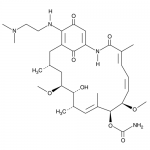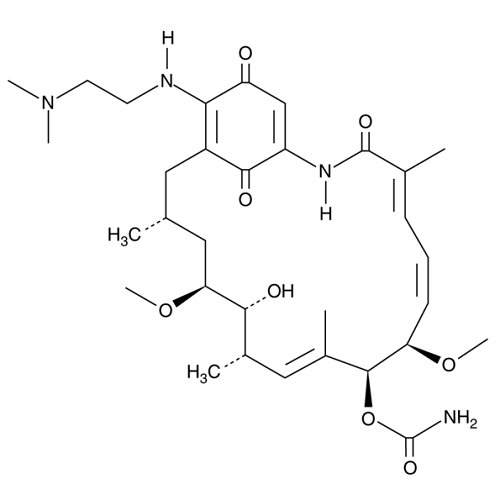| Product Name | 17-DMAG |
| Description |
Hsp90 inhibitor |
| Purity | >98% (TLC); NMR (Conforms) |
| CAS No. | 467214-20-6 |
| Molecular Formula | C32H48N4O8 |
| Molecular Weight | 616.8 |
| Field of Use | Not for use in humans. Not for use in diagnostics or therapeutics. For in vitro research use only. |
Properties
| Storage Temperature | -20ºC |
| Shipping Temperature | Shipped Ambient |
| Product Type | Inhibitor |
| Solubility | Soluble in DMSO (30 mg/ml) and ethanol (10 mg/ml) |
| Source | Synthetic |
| Appearance | Purple Solid |
| SMILES | C[C@H]1C[C@@H]([C@@H]([C@H](/C=C(/[C@@H]([C@H](/C=CC=C(C(=O)NC2=CC(=O)C(=C(C1)C2=O)NCCN(C)C)/C)OC)OC(=O)N)C)C)O)OC |
| InChI | InChI=1S/C32H48N4O8/c1-18-14-22-27(34-12-13-36(5)6)24(37)17-23(29(22)39)35-31(40)19(2)10-9-11-25(42-7)30(44-32(33)41)21(4)16-20(3)28(38)26(15-18)43-8/h9-11,16-18,20,25-26,28,30,34,38H,12-15H2,1-8H3,( |
| InChIKey | KUFRQPKVAWMTJO-LMZWQJSESA-N |
| Safety Phrases |
Classification: Caution: Substance not yet fully tested. Safety Phrases: S22 - Do not breathe dust S24/25 - Avoid contact with skin and eyes S36/37/39 - Wear suitable protective clothing, gloves and eye/face protection |
| Cite This Product | 17-DMAG (StressMarq Biosciences Inc., Victoria BC CANADA, Catalog # SIH-114) |
Biological Description
| Alternative Names | Alvespimycin, 17DMAG, 17-(dimethylaminoethylamino)-17-demethoxy-geldanamycin, 17-(dimethylaminoethylamino)-17-demethoxygeldanamycin, 17-desmethoxy-17-n,n-dimethylaminoethylamino-geldanamycin, 17-dimethylaminoethylamino-17-demethoxy-geldanamycin, 17-DMAG, 17-Dimethylaminoethylamino, 17-Demethoxygeldanamycin, [(3R,5S,6R,7S,8E,10S,11S,12Z,14E)-21-[2-(dimethylamino)ethylamino]-6-hydroxy-5,11-dimethoxy-3,7,9,15-tetramethyl-16,20,22-trioxo-17-azabicyclo[16.3.1]docosa-1(21),8,12,14,18-pentaen-10-yl] carbamate |
| Research Areas | Cancer, Heat Shock |
| PubChem ID | 5288674 |
| Scientific Background | 17-DMAG (17-dimethylaminoethylamino-17-demethoxygeldanamycin) is a water-soluble, bioavailable analog of geldanamycin and 17-AAG, designed to overcome the solubility and toxicity limitations of its predecessors. As a high-affinity HSP90 inhibitor, 17-DMAG disrupts the stability of client proteins involved in neurodegenerative disease pathways. Preclinical studies highlight its ability to induce autophagy and promote the clearance of alpha-synuclein aggregates, a hallmark of Parkinson’s disease and related disorders. Its favorable pharmacokinetic profile, including efficient tissue distribution and reduced metabolic degradation, makes 17-DMAG a compelling candidate for CNS-targeted therapies. By enhancing proteostasis and mitigating protein aggregation, 17-DMAG represents a promising tool for modulating neurodegenerative processes at the molecular chaperone level. |
| References |
1. Bull E.E., et al.(2004) Clin. Cancer Res. 10: 8077. 2. Gossett D.R. et al.(2005) Gynecol. Oncol. 96: 381. 3. Kaur G. et al.(2004) Clin. Cancer Res. 10: 4813. |



Reviews
There are no reviews yet.